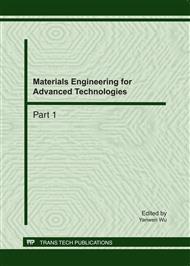p.472
p.478
p.484
p.490
p.496
p.502
p.507
p.513
p.519
550°C-Based Py-GC/MS Analysis of Chemical Components of Benzene/Ethanol Extractives from Trunk Bark of Cinnamomum camphora
Abstract:
Researches about the analysis and identificaion of chemical components of old bark from Cinnamomum camphora trunk were very less. Therefore, 550 °C-based pyrolysis- GC/MS technology was used to identify the top value-added biomedical constituents of old bark-based benzene/ethanol extractives from C. camphora trunk. 107 chemical constituents representing 99.316% were identified from 120 peaks. The main components are as: 1-Nonadecene (6.313% from two peaks), Octacosane (5.749% from two peaks), Octacosanoic acid, methyl ester (4.706%), 9-Tricosene, (Z)- (4.273% from seven peaks), 2-Methoxy-4-vinylphenol (2.385% from three peaks), Pyridine-3-carboxamide, oxime, N-(2-trifluoromethylphenyl)- (2.320% from three peaks), 25-Noroleana-9,12-dien-29-oic acid, 5-methyl-11-oxo-, (18.alpha.)- (2.165%), Cyclotriacontane (2.117%), Nonacosane (1.947%), 2-Pentene, (E)- (1.933%), Octadecane (1.932% from two peaks), Octacosane (1.898%), Hexacosanoic acid, methyl ester (1.861%), 1,2-Benzenedicarboxylic acid, butyl 2-methylpropyl ester (1.849%), Tetracosanoic acid, methyl ester (1.774%), 1-Hexene (1.742), Cyclotetracosane (1.719%), Hexadecane (1.435% from two peaks), etc. The result of functional analysis suggested that the 550 °C pyrolyzate of benzene/ethanol extractives from C. camphora old bark is abundant in biomedical constituents and other bioactive components, which can be used as top value-added materials of high-grade cosmetic, food, spice and chemical solvents.
Info:
Periodical:
Pages:
496-501
Citation:
Online since:
June 2011
Authors:
Price:
Сopyright:
© 2011 Trans Tech Publications Ltd. All Rights Reserved
Share:
Citation:


